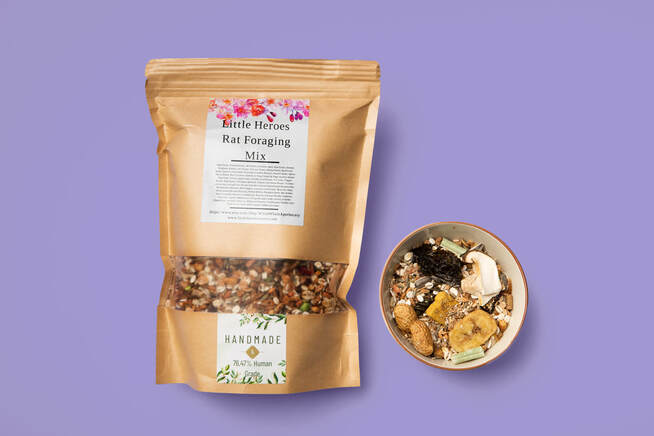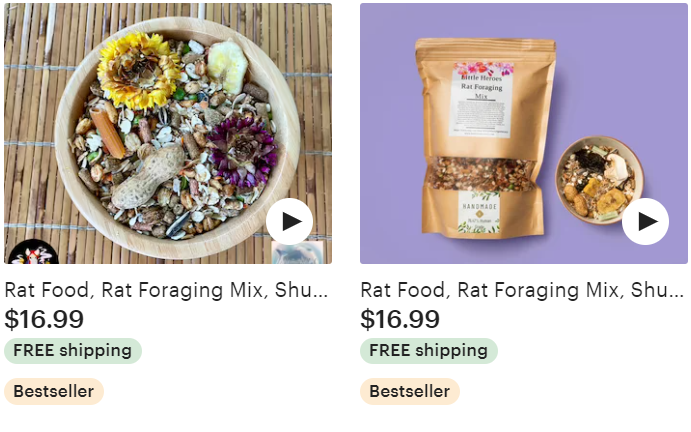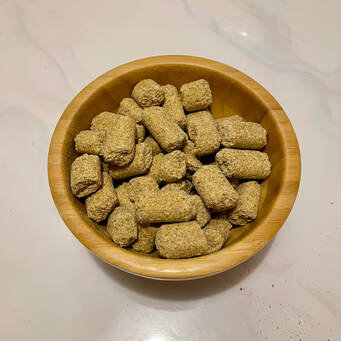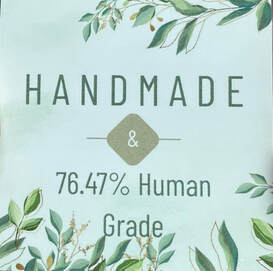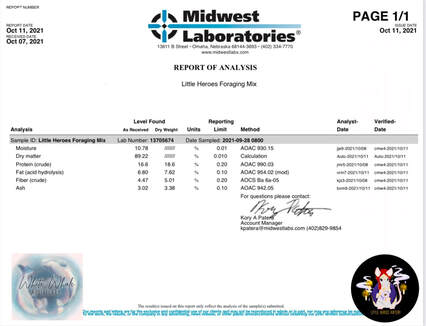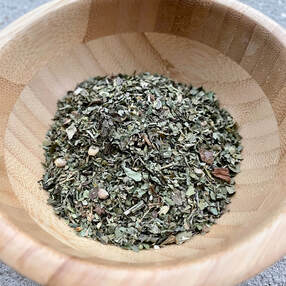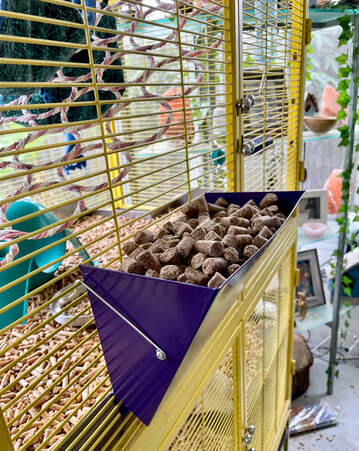Diet, Nutrition & More
You can buy directly, here
Our rat's base diet consists of a grain mix we make ourselves + fresh fruits/veggies 2-3 times per week. A rats ideal protein intake is around 14%-16% - and Mazuri recently upped their protein level to 23%... this is pretty high. Because increased protein is directly linked to Protein Itch in rats (especially males, and most especially in Hairless or rats with Harley coats), we have made the decision to change over entirely.
At this time, we are recommending Oxbow Lab Blocks (16% protein), or Kalmbach (18% protein). These lab blocks are a completely balanced diet and should be the primary food source, unless you are willing to put in the effort to assemble a complete grain diet.
You can find a complete list of dietary supplements here on the AFRMA page. A diet that is both well-balanced and low in excessive fats and protein is very important.
The food mix that our rats live on consists of a grain mix that we create here based on the Shunamite diet. the nutritional notions examined and explained by Isamu Rats (a reputable breeder in the UK), and our own research from The Scuttling Gourmet; a complete rat nutrition book that we recommend if you are considering crafting your own mix.
Our foraging mix is handcrafted here at the Rattery, in a separate airspace than which our rats reside. I have put together this mix using basic principals of the Shunamite Diet (with alterations made using US-found ingredients). In 2023 we even procured our own industrial freeze dryer, so we can mix up the fruit/veg/protein ingredients each month to keep it interesting!
76.47% of the ingredients in our mix are made using human-grade ingredients!
At this time, we are recommending Oxbow Lab Blocks (16% protein), or Kalmbach (18% protein). These lab blocks are a completely balanced diet and should be the primary food source, unless you are willing to put in the effort to assemble a complete grain diet.
You can find a complete list of dietary supplements here on the AFRMA page. A diet that is both well-balanced and low in excessive fats and protein is very important.
The food mix that our rats live on consists of a grain mix that we create here based on the Shunamite diet. the nutritional notions examined and explained by Isamu Rats (a reputable breeder in the UK), and our own research from The Scuttling Gourmet; a complete rat nutrition book that we recommend if you are considering crafting your own mix.
Our foraging mix is handcrafted here at the Rattery, in a separate airspace than which our rats reside. I have put together this mix using basic principals of the Shunamite Diet (with alterations made using US-found ingredients). In 2023 we even procured our own industrial freeze dryer, so we can mix up the fruit/veg/protein ingredients each month to keep it interesting!
76.47% of the ingredients in our mix are made using human-grade ingredients!
Our mixture has been sent for independent analysis and has come in with the following guaranteed analysis:
Protein (crude): 16.6%
Fat (acid hydrolysis): 6.80%
Fiber (crude): 4.47%
We also sell this mixture ourselves for local pickup, or shipped via our affiliate Etsy shoppe, here. Please note that when purchasing in-person, there is a steep discount from the prices you see on Etsy (which cover shipping costs). In-person, our Little Heroes Foraging Mix is $6.76 per pound, or $5.40 per pound if purchasing 20+ pounds at one time). You can now purchase this directly, here!
Our diet is even used and recommended by a licensed doctor of veterinary medicine! You can read their testimonial, here:
"I highly recommend Little Heroes Rat Foraging Mix for rats of all types and life stages over 2 weeks old. As a veterinarian, rat enthusiast, and rat breeder, I've tried several high-quality diets for my ratties, and HERO's mix is by far my favorite due to its unwavering superior quality and palatability.
My rats absolutely love it -- they recognize the sound of the bag opening and they enthusiastically wallpaper to their cage doors with their bodies as I bring the goodies to them -- and they thrive on it as well, easily maintaining ideal body condition and coast quality. Little Heroes Rat Foraging Mix is also excellent for rat kittens as they wean onto solid foods. The variety of small pieces gives them a wide choice, easily handled by tiny paws, and this helps introduce them to good, healthy foods that they may encounter in the future.
Overall, Little Heroes Rat Foraging Mix is an excellent, high quality diet that your ratties of all ages will love!"
-- Sara M., DVM
Protein (crude): 16.6%
Fat (acid hydrolysis): 6.80%
Fiber (crude): 4.47%
We also sell this mixture ourselves for local pickup, or shipped via our affiliate Etsy shoppe, here. Please note that when purchasing in-person, there is a steep discount from the prices you see on Etsy (which cover shipping costs). In-person, our Little Heroes Foraging Mix is $6.76 per pound, or $5.40 per pound if purchasing 20+ pounds at one time). You can now purchase this directly, here!
Our diet is even used and recommended by a licensed doctor of veterinary medicine! You can read their testimonial, here:
"I highly recommend Little Heroes Rat Foraging Mix for rats of all types and life stages over 2 weeks old. As a veterinarian, rat enthusiast, and rat breeder, I've tried several high-quality diets for my ratties, and HERO's mix is by far my favorite due to its unwavering superior quality and palatability.
My rats absolutely love it -- they recognize the sound of the bag opening and they enthusiastically wallpaper to their cage doors with their bodies as I bring the goodies to them -- and they thrive on it as well, easily maintaining ideal body condition and coast quality. Little Heroes Rat Foraging Mix is also excellent for rat kittens as they wean onto solid foods. The variety of small pieces gives them a wide choice, easily handled by tiny paws, and this helps introduce them to good, healthy foods that they may encounter in the future.
Overall, Little Heroes Rat Foraging Mix is an excellent, high quality diet that your ratties of all ages will love!"
-- Sara M., DVM
If feeding this mix, fruits/veggies are *necessary* for rats to get the correct vitamins/minerals. If you do not intend to feed these items on a regular basis (2-3 times per week), we encourage you to supplement 50% lab blocks and 50% of the above mix. Alternately, you can add vitamin and calcium supplements (as we do here) on a regular basis (3 times per week, ideally). You can get the Daily Essentials 1 from Lady Gouldian Finch. You want to get Dr. Squiggles CalciBoost Powder & Daily Essentials 3, if you are able to find them. This can be purchased in powder (to put on food) or liquid form.
We are now offering HERO Drops (Yogurt Drops) with Dr. S's Daily Essentials 1 and Calcium. You can buy them, here!
We are now offering HERO Drops (Yogurt Drops) with Dr. S's Daily Essentials 1 and Calcium. You can buy them, here!
Please Note: A minimum of two (2) water bottles or sources of water should be available in your cage at all times. Should one bottle become jammed, there will be a back up. Rats also love the opportunity to wash their little faces; so I like to keep a bowl of water in their enclosures as well.
I recommend the Choco Nose Bottle, which you can find on Amazon, here.
Make sure you get the one for rats and NOT rabbits (the nip is too large). These bottles are amazing, because not only can you unscrew the nipple and disassemble it entirely for a thorough cleansing - but you the bottle itself can be replaced! It is compatible with 16oz soda bottles - and from what I've heard, it can also fit a Trader Joes wine bottle (so long as you use a bungee cord to help support the weight of it).
I recommend the Choco Nose Bottle, which you can find on Amazon, here.
Make sure you get the one for rats and NOT rabbits (the nip is too large). These bottles are amazing, because not only can you unscrew the nipple and disassemble it entirely for a thorough cleansing - but you the bottle itself can be replaced! It is compatible with 16oz soda bottles - and from what I've heard, it can also fit a Trader Joes wine bottle (so long as you use a bungee cord to help support the weight of it).
Self Medicating with Herbs
(We offer an ever-slightly-changing bowl of herbs for our rats to free feed off of as they need. We also include many herbs in our Little Heroes Rat Foraging Mix.
We recommend collecting some or all of these (dried) herbs and putting them in a dish to free feed. The rats will pick what they want and need from the mix.
Chickweed: containing vitamins B6, B12 and C.
Dandelion: excellent source of vitamin A, C, K, D and B complex; they contain 20% protein- twice that of spinach; and are a good source of minerals, including trace minerals.
Dill: has also been shown to inhibit the growth of several bacteria which cause infectious diarrhea, also kills parasites.
Milk Thistle: is an antioxidant and liver cleanser.
Plantain: anti inflammatory, antibacterial, aids in digestion and helps respiratory ailments.
Garlic Powder: anti parasite, immune builder, detoxifying, powerful natural antibiotic.
Barley Grass: barley grass powder contains eleven times the calcium of cow's milk, five times the iron of spinach, four times the vitamin B1 of whole wheat flour, seven times the vitamin C found in oranges, and is a good source of vitamin B12. Possess many times the nutritional potency of green vegetables. Contains vegetable protein and high in minerals.
Spirulina: studies have shown that Spirulina protected birds from infection with the antibiotic-resistant Staphylococcus aureus and E. coli. Its a powerful immune builder. High in protein.
Parsley: It contains more vitamin C than any other standard culinary vegetable, approximately three times as much as oranges and about the same as blackcurrants. The iron content is exceptional (twice as much as spinach) and the plant is a good source of manganese, calcium and potassium. It also contains flavonoids that act as antioxidants. Parsley is also rich in vitamin A, well-known for its effects on vision, plus can mitigate risks of atherosclerosis and diabetes. Raw parsley cleanses the blood, dissolves sticky deposits in veins, maintains elasticity of blood vessels, facilitates removal of moderately sized kidney and gallstones, treats deafness and ear infections, and benefits the sexual system.
Cinnamon: is great for blood circulation and for anti blood clotting. It’s great for the libido. It stops the growth of bacteria and fungi. Kills candida which causes respiratory distress and cancer. In addition to its unique essential oils, cinnamon is an excellent source of the trace mineral manganese and a very good source of dietary fiber, iron and calcium. Smells heavenly too and this causes increase in brain function! This also functions to mask the scent of the overall mixture (this is for your benefit!)
Oregano: Studies have shown that both of these compounds can inhibit the growth of bacteria, virus and fungi which is the main causes of many illnesses such as respiratory problems.
Peppermint: is an excellent source of vitamin C and vitamin A. Peppermint is a very good source of magnesium, folate, dietary fiber, calcium, iron, and vitamin B2. Aids in digestion, helps headache and prevents cancer.
Basil: also exhibits anti-inflammatory properties, anti-fungal properties. Basil is a source for Vitamin K, iron, calcium, vitamin A, manganese, magnesium, vitamin C, and potassium. It is good for the heart, because it helps to prevent build-up in the arteries and fights free radicals. The magnesium helps blood vessels to relax which increases blood circulation.
Another dry green mix I use contains Eucalyptus, Dandelion, Oat straw, Plantain, red clover, Echinacea, Milk thistle, Pau D'Arco, elderberry, Yarrow, Olive leaf, Thyme leaf, Lavender, Wheat grass, garlic, Spirulina, Astragulus, Barberry, Chickweed, & Kelp.
***Most of these (human-grade) can be obtained at Leaves & Roots: 9476 E. Colonial Dr. Orlando, FL. ***
Borrowed with permission and minimally modified from: Camarattery
We recommend collecting some or all of these (dried) herbs and putting them in a dish to free feed. The rats will pick what they want and need from the mix.
Chickweed: containing vitamins B6, B12 and C.
Dandelion: excellent source of vitamin A, C, K, D and B complex; they contain 20% protein- twice that of spinach; and are a good source of minerals, including trace minerals.
Dill: has also been shown to inhibit the growth of several bacteria which cause infectious diarrhea, also kills parasites.
Milk Thistle: is an antioxidant and liver cleanser.
Plantain: anti inflammatory, antibacterial, aids in digestion and helps respiratory ailments.
Garlic Powder: anti parasite, immune builder, detoxifying, powerful natural antibiotic.
Barley Grass: barley grass powder contains eleven times the calcium of cow's milk, five times the iron of spinach, four times the vitamin B1 of whole wheat flour, seven times the vitamin C found in oranges, and is a good source of vitamin B12. Possess many times the nutritional potency of green vegetables. Contains vegetable protein and high in minerals.
Spirulina: studies have shown that Spirulina protected birds from infection with the antibiotic-resistant Staphylococcus aureus and E. coli. Its a powerful immune builder. High in protein.
Parsley: It contains more vitamin C than any other standard culinary vegetable, approximately three times as much as oranges and about the same as blackcurrants. The iron content is exceptional (twice as much as spinach) and the plant is a good source of manganese, calcium and potassium. It also contains flavonoids that act as antioxidants. Parsley is also rich in vitamin A, well-known for its effects on vision, plus can mitigate risks of atherosclerosis and diabetes. Raw parsley cleanses the blood, dissolves sticky deposits in veins, maintains elasticity of blood vessels, facilitates removal of moderately sized kidney and gallstones, treats deafness and ear infections, and benefits the sexual system.
Cinnamon: is great for blood circulation and for anti blood clotting. It’s great for the libido. It stops the growth of bacteria and fungi. Kills candida which causes respiratory distress and cancer. In addition to its unique essential oils, cinnamon is an excellent source of the trace mineral manganese and a very good source of dietary fiber, iron and calcium. Smells heavenly too and this causes increase in brain function! This also functions to mask the scent of the overall mixture (this is for your benefit!)
Oregano: Studies have shown that both of these compounds can inhibit the growth of bacteria, virus and fungi which is the main causes of many illnesses such as respiratory problems.
Peppermint: is an excellent source of vitamin C and vitamin A. Peppermint is a very good source of magnesium, folate, dietary fiber, calcium, iron, and vitamin B2. Aids in digestion, helps headache and prevents cancer.
Basil: also exhibits anti-inflammatory properties, anti-fungal properties. Basil is a source for Vitamin K, iron, calcium, vitamin A, manganese, magnesium, vitamin C, and potassium. It is good for the heart, because it helps to prevent build-up in the arteries and fights free radicals. The magnesium helps blood vessels to relax which increases blood circulation.
Another dry green mix I use contains Eucalyptus, Dandelion, Oat straw, Plantain, red clover, Echinacea, Milk thistle, Pau D'Arco, elderberry, Yarrow, Olive leaf, Thyme leaf, Lavender, Wheat grass, garlic, Spirulina, Astragulus, Barberry, Chickweed, & Kelp.
***Most of these (human-grade) can be obtained at Leaves & Roots: 9476 E. Colonial Dr. Orlando, FL. ***
Borrowed with permission and minimally modified from: Camarattery
Vegetables & Fruit
There is a wide variety of vegetables and fruit that are safe for rats. Humans and rats have coexisted (whether we liked it or not) for decades... this is because we prefer similar habitats, living environments and diets!
A good rule of thumb is to feed along the following ratios:
50% leafy veg (10-15% of which can be herbs)
20% colorful veg
10% legumes
10% others
10% fruit (avoid citrus for male rats)
You can do your own research if you have personal household staples and want to see if you can share those. There are a myriad of health benefits; and you can find more information from a source we love, here, on Isamu Rats webpage (a well-respected breeder in the UK).
What we find easiest (and best) for us here, is to go on a big shopping day (since we are providing for so many rats at varying life stages and with an equally colorful variety of needs) about once every 2-4 weeks. We will choose our mixture based on local availability alongside nutritional goals. We will then wash everything well, chop it all up, mix it together and individually package it into portion sizes that work for us. Label them with ingredients and the date - pop into the freezer = freezer veg pops! Rats LOVE them!
We will typically chop up 2 separate mixtures so we can offer variety throughout the month. Its best to tap the block of frozen veg with a mallet (lightly) or let it set out at room temperature for about 15 minutes before dropping into their dishes - this way one rat doesn't try to take off with the whole block.
Don't leave this in their cage longer than a few hours - as these items will spoil after some time.
As a side note: I use the multi-level Dehydro food dehydrator so that I can dry out large batches of fruit or whatnot at one time. I have it set up in my garage, because dehydrating food takes *hours* and it is not a silent machine. It's very useful, however! I can also make fruit leather for my kids, so its a win win over here.
A good rule of thumb is to feed along the following ratios:
50% leafy veg (10-15% of which can be herbs)
20% colorful veg
10% legumes
10% others
10% fruit (avoid citrus for male rats)
You can do your own research if you have personal household staples and want to see if you can share those. There are a myriad of health benefits; and you can find more information from a source we love, here, on Isamu Rats webpage (a well-respected breeder in the UK).
What we find easiest (and best) for us here, is to go on a big shopping day (since we are providing for so many rats at varying life stages and with an equally colorful variety of needs) about once every 2-4 weeks. We will choose our mixture based on local availability alongside nutritional goals. We will then wash everything well, chop it all up, mix it together and individually package it into portion sizes that work for us. Label them with ingredients and the date - pop into the freezer = freezer veg pops! Rats LOVE them!
We will typically chop up 2 separate mixtures so we can offer variety throughout the month. Its best to tap the block of frozen veg with a mallet (lightly) or let it set out at room temperature for about 15 minutes before dropping into their dishes - this way one rat doesn't try to take off with the whole block.
Don't leave this in their cage longer than a few hours - as these items will spoil after some time.
As a side note: I use the multi-level Dehydro food dehydrator so that I can dry out large batches of fruit or whatnot at one time. I have it set up in my garage, because dehydrating food takes *hours* and it is not a silent machine. It's very useful, however! I can also make fruit leather for my kids, so its a win win over here.
Going on Vacation?
Rat cannot be left alone for prolonged periods of time, however, if you are going on vacation for a couple of days and/or want a backup failsafe for their foods; use a hopper! Many people choose to build their own, using either hardware cloth or dollar-store baskets. These works great, too! But if you, like us, prefer to purchase one ready-made - here you go! You can find this Ware Hay Rack (intended for rabbits/guinea pigs), here. This works fantastically as a rat food hopper; keeping lab blocks outside the bars of their cage where they cannot stash them or get them wet. Its a gravity system: when they nibble on the blocks through the bars, the ones near the top drop down and replace them. This halts food-hoarding and ensures the food supply lasts longer than it otherwise would.
We use these if we are going to be out of town for any amount of time - and like to keep them stocked just in case of emergency.
We use these if we are going to be out of town for any amount of time - and like to keep them stocked just in case of emergency.
Base Diet: An Informed Comparison 2021
I spent quite a bit of time comparing the various base block diets to the mix I have made here. I wanted to offer this information, so you can be as informed as possible. Keep in mind the recommended value for protein in particular. This is information I have compiled in 2021 and I present for your own education.
Little Heroes Rat Foraging Mix
Protein (crude): 16.6%
Fat (acid hydrolysis): 6.80%
Fiber (crude): 4.47%
Mazuri Lab Blocks
Protein: 23%
Fat: 6.5%
Fiber: 4.5%
Moisture: 12%
Oxbow Lab Blocks
Protein: 15%
Fat: 4%
Fiber: 2%
Moisture: 10%
Teklad Lab Blocks
Protein: 24.3%
Fat: 4.7%
Fiber: 4.0%
Moisture: ?
Kalmbach Feeds 18% (also offered in 23%)
Protein: 18%
Fat: 6%
Fiber: 6%
Moisture: ?
Little Heroes Rat Foraging Mix
Protein (crude): 16.6%
Fat (acid hydrolysis): 6.80%
Fiber (crude): 4.47%
Mazuri Lab Blocks
Protein: 23%
Fat: 6.5%
Fiber: 4.5%
Moisture: 12%
Oxbow Lab Blocks
Protein: 15%
Fat: 4%
Fiber: 2%
Moisture: 10%
Teklad Lab Blocks
Protein: 24.3%
Fat: 4.7%
Fiber: 4.0%
Moisture: ?
Kalmbach Feeds 18% (also offered in 23%)
Protein: 18%
Fat: 6%
Fiber: 6%
Moisture: ?
©Little Heroes Rattery 2021-2024
